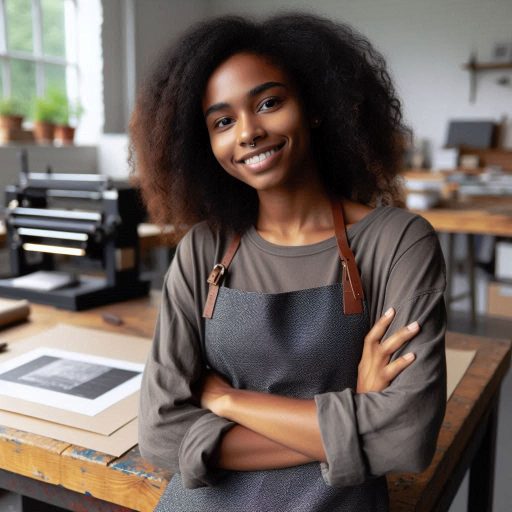Introduction
Printmaking is a fascinating art form that involves creating images or designs through various techniques like linocut, woodcut, etching, and screen printing.
It is a versatile medium that allows beginners to explore their creativity in a hands-on way.
Using materials such as carving tools, ink, paper, and printing presses, beginners can experiment with different textures, shapes, and colors to produce unique prints.
Learning printmaking can be a rewarding experience as it enhances problem-solving skills, attention to detail, and patience.
In addition to providing a fun and engaging hobby, printmaking can also serve as a therapeutic activity that promotes mindfulness and relaxation.
As beginners dive into the world of printmaking, they will discover new techniques, develop their own artistic style, and gain a sense of accomplishment with each print they create.
Understanding Printmaking
Definition and History
Printmaking is a form of art where artwork is created by transferring ink or pigment onto paper or another material.
This process involves creating a template or matrix, which is then pressed onto the surface to create an image.
Printmaking has a rich history that dates back to ancient civilizations and has been used as a medium for expression and communication.
Types of Printmaking Techniques
There are several types of printmaking techniques, each with its own unique process and characteristics. Some common techniques include:
- Relief Printing: This technique involves carving away the negative space of an image onto a block, which is then inked and pressed onto paper.
- Intaglio Printing: Intaglio prints are created by incising or etching an image onto a metal plate, which is then filled with ink and wiped clean on the surface.
- Lithography: In lithography, a greasy drawing is made on a smooth surface, usually a stone, and then inked and transferred onto paper.
- Screen Printing: Screen printing involves creating a stencil on a mesh screen, and then applying ink onto the surface, which is pressed onto the paper.
Basic Materials Needed
To get started with printmaking, you will need a few basic materials, including:
- Ink: There are various types of ink available for printmaking, such as oil-based, water-based, and acrylic.
- Brayers: Brayers are roller tools used to apply ink onto the printing surface evenly.
- Carving Tools: These tools are used to carve or etch the image onto the block or plate for relief or intaglio printing.
- Paper: Different types of paper, such as printmaking paper, watercolor paper, or handmade paper, can be used for printing the final image.
By familiarizing yourself with these techniques and materials, you can start exploring the world of printmaking and creating your unique artwork.
Practice and experimentation are key to mastering this art form, so don’t be afraid to get creative and try out new ideas. Happy printing!
Read: Exploring Printmaking in Graphic Design
Choosing a DIY Printmaking Project
Examples of simple printmaking projects suitable for beginners
When it comes to starting out in printmaking, it’s essential to select projects that are beginner-friendly.
Here are some simple printmaking projects that are perfect for those who are new to the craft:
- Creating Greeting Cards: Designing and printing your own custom greeting cards can be a fun and rewarding project.
You can experiment with different colors, patterns, and textures to make each card unique. - Making Bookmarks: Bookmarks are another great project for beginners.
You can play around with various shapes and sizes, as well as different motifs and illustrations to create personalized bookmarks for yourself or to give as gifts. - Designing Postcards: Printmaking postcards is a creative way to share your artwork with others.
You can choose to focus on a specific theme or create a series of postcards that showcase your artistic style.
Exploring different themes or styles for printmaking projects
If you’re unsure about what theme or style to explore in your printmaking projects, consider the following suggestions:
- Botanical Prints: Drawing inspiration from nature, botanical prints involve using plants, flowers, and other natural elements to create intricate and beautiful designs.
- Abstract Designs: Abstract printmaking allows for a lot of creativity and experimentation.
You can play with shapes, colors, and textures to produce one-of-a-kind abstract pieces. - Typography: Incorporating text into your printmaking projects can add a unique and personal touch.
Experiment with different fonts, sizes, and layouts to create visually engaging prints.
Importance of starting with small, manageable projects to build confidence and skill
It’s important to remember that as a beginner, starting with small and manageable projects is key to building your confidence and skills in printmaking.
By starting with simple projects, you can learn the basics of printmaking techniques and gradually progress to more complex projects as you gain experience.
Read: Best Glass Art Schools in the USA
Transform Your Career Today
Unlock a personalized career strategy that drives real results. Get tailored advice and a roadmap designed just for you.
Start NowSetting Up Your Workspace
When starting your printmaking journey, having a well-organized workspace is essential for optimal creativity and productivity.
Here are some tips to help you set up your workspace:
Proper Lighting
- Choose a well-lit area for your workspace to ensure you can see your work clearly.
- Consider adding task lighting, such as a desk lamp, to illuminate your work surface effectively.
Ventilation
- Ensure your workspace is well-ventilated to avoid inhaling fumes from printmaking materials.
- Consider opening windows or using a fan to improve air circulation in your workspace.
Storage for Materials
- Invest in storage solutions such as shelves, drawers, or bins to keep your printmaking materials organized.
- Label containers and shelves to easily find and access your tools and supplies when needed.
Essential Tools
- Consider investing in a printing press for more professional results in your printmaking projects.
- If a printing press is not within your budget, you can create a makeshift press using a wooden spoon or a barren.
Experimentation with Techniques and Tools
- Encourage beginners to explore different printmaking techniques such as linocut, woodcut, or etching.
- Experiment with various tools like brayers, carving tools, and inks to discover what works best for your style.
By setting up a functional and organized workspace, investing in essential tools, and experimenting with different techniques and tools, beginners can enhance their printmaking skills and creativity.
Remember, practice makes perfect, so don’t be afraid to try new things and push your boundaries in the world of printmaking!
Read: How to Price Your Printmaking Artwork

Step-by-Step Guide to Printmaking
Basic Steps Involved in a Printmaking Project
- Sketching a design: Begin by drawing your design on a piece of paper or directly on the printing block.
- Transferring it onto a printing block: Use transfer paper or tracing paper to transfer your design onto the block.
- Carving the block: Use carving tools to carefully carve out the areas of the block that you want to print.
- Applying ink: Roll out a thin, even layer of ink onto a flat surface and then roll the ink onto your block.
- Printing: Place your paper on top of the inked block and apply pressure to transfer the design onto the paper.
Detailed Instructions for Each Step
- Sketching a design: Use a pencil to sketch your design, making sure to include details and textures that you want to show up in the final print.
- Transferring it onto a printing block: Place your design face down on the block and rub the back of the paper to transfer the image.
- Carving the block: Start by carving the outline of your design and then gradually remove more material to create depth and detail.
- Applying ink: Use a brayer to roll the ink onto your block in a thin, even layer, making sure not to over-ink.
- Printing: Carefully place your paper on the block, then use a baren or a spoon to apply pressure evenly across the paper.
Tips for Achieving Clean Prints
- Use high-quality paper and ink for best results.
- Keep your tools clean and sharp to ensure crisp lines.
- Apply even pressure when printing to avoid smudges.
- Experiment with different pressures and inking techniques to achieve different effects.
- Practice on scrap paper before printing your final piece.
Troubleshooting Common Issues
- Blurry prints: Make sure your block is properly inked and apply even pressure when printing.
- Uneven prints: Check for inconsistencies in your inking or pressure application.
- Ink bleeding: Use less ink on your block and make sure your paper is flat when printing.
- Smudges: Avoid touching the inked surface of your block or paper before printing.
- Low contrast: Adjust your design to include more defined lines and details for better printing results.
By following these step-by-step instructions, tips, and troubleshooting advice, beginners can create beautiful prints with ease.
Practice and experimentation are key to mastering the art of printmaking.
Read: Top Skills Needed for Glass Art Design
Exploring Advanced Techniques
Once beginners have mastered the basics of printmaking, they can start exploring more advanced techniques.
These techniques open up a whole new world of creative possibilities and allow artists to push the boundaries of their skills.
Here are some advanced printmaking techniques that beginners can experiment with:
Reduction Printing
Reduction printing is a technique where the same block is used for multiple colors, carving away more of the block after each color is printed.
This process creates intricate and layered prints that can be stunning in their complexity.
Collagraphy
Collagraphy is a printmaking technique where materials are collaged onto a printing plate to create texture and depth.
Beginners can experiment with different materials such as cardboard, fabric, and textured paper to create unique and interesting prints.
Monoprinting
Monoprinting is a versatile technique where each print is unique.
This technique allows beginners to experiment with different mark-making processes, such as drawing directly on the printing plate or using stencils.
The results can be unpredictable and exciting.
Cyanotype Printing
Cyanotype printing is a photographic printing process that uses a light-sensitive emulsion to create a cyan-blue print.
Beginners can experiment with creating photograms or using digital negatives to create unique and ethereal prints.
Transform Your Career Today
Unlock a personalized career strategy that drives real results. Get tailored advice and a roadmap designed just for you.
Start NowThis technique is a great way to introduce photography into printmaking.
By exploring these advanced techniques, beginners can take their printmaking skills to the next level.
These techniques offer endless creative possibilities and allow artists to experiment and grow in their practice.
So don’t be afraid to try something new and see where your creativity takes you!
Gain More Insights: Advertising Design: Legal and Ethical Considerations
Sharing Your Work
Sharing your printmaking projects with others is an important part of your artistic journey.
Whether through social media, art shows, or gift-giving, sharing your work allows you to connect with a larger audience and receive feedback on your creations.
Importance of Sharing Your Printmaking Projects
- Allows you to showcase your talent and progress.
- Opens up opportunities for networking and collaboration.
- Inspires others to explore printmaking as well.
- Builds your confidence as an artist.
Tips for Photographing and Documenting Your Prints
- Use natural lighting to capture the true colors and details of your prints.
- Experiment with different angles and compositions to find the most visually appealing shot.
- Edit your photos to enhance colors and clarity, but be careful not to overdo it.
- Provide context by including close-up shots, in-progress photos, and behind-the-scenes glimpses.
Connecting with Other Printmakers
- Join online printmaking communities or forums to share your work and seek advice from experienced artists.
- Attend local art groups, workshops, or classes to meet fellow printmakers in person.
- Collaborate on projects with other artists to learn new techniques and expand your creative horizons.
- Participate in print exchanges or collaborative exhibitions to showcase your work to a wider audience.
By sharing your printmaking projects and connecting with other artists, you not only enhance your skills but also enrich your overall artistic experience.
Remember, art is meant to be shared and appreciated by others, so don’t hesitate to showcase your creations with the world!
Conclusion
DIY printmaking offers beginners a creative outlet to express themselves.
It allows for experimentation and personalization, fostering a sense of accomplishment with each project completed.
The benefits of DIY printmaking include developing new skills, boosting confidence, and unleashing one’s creativity in a fun and engaging way.
It also provides a stress-relieving and meditative activity that can be enjoyed by people of all ages.
I encourage readers to take the leap into the world of printmaking.
Embrace the opportunity to learn and grow as an artist while exploring a new hobby that can bring joy and fulfillment.
Share your printmaking projects and experiences in the comments section below.
Let’s inspire and support each other on this creative journey.
Remember, the only limit is your imagination!




